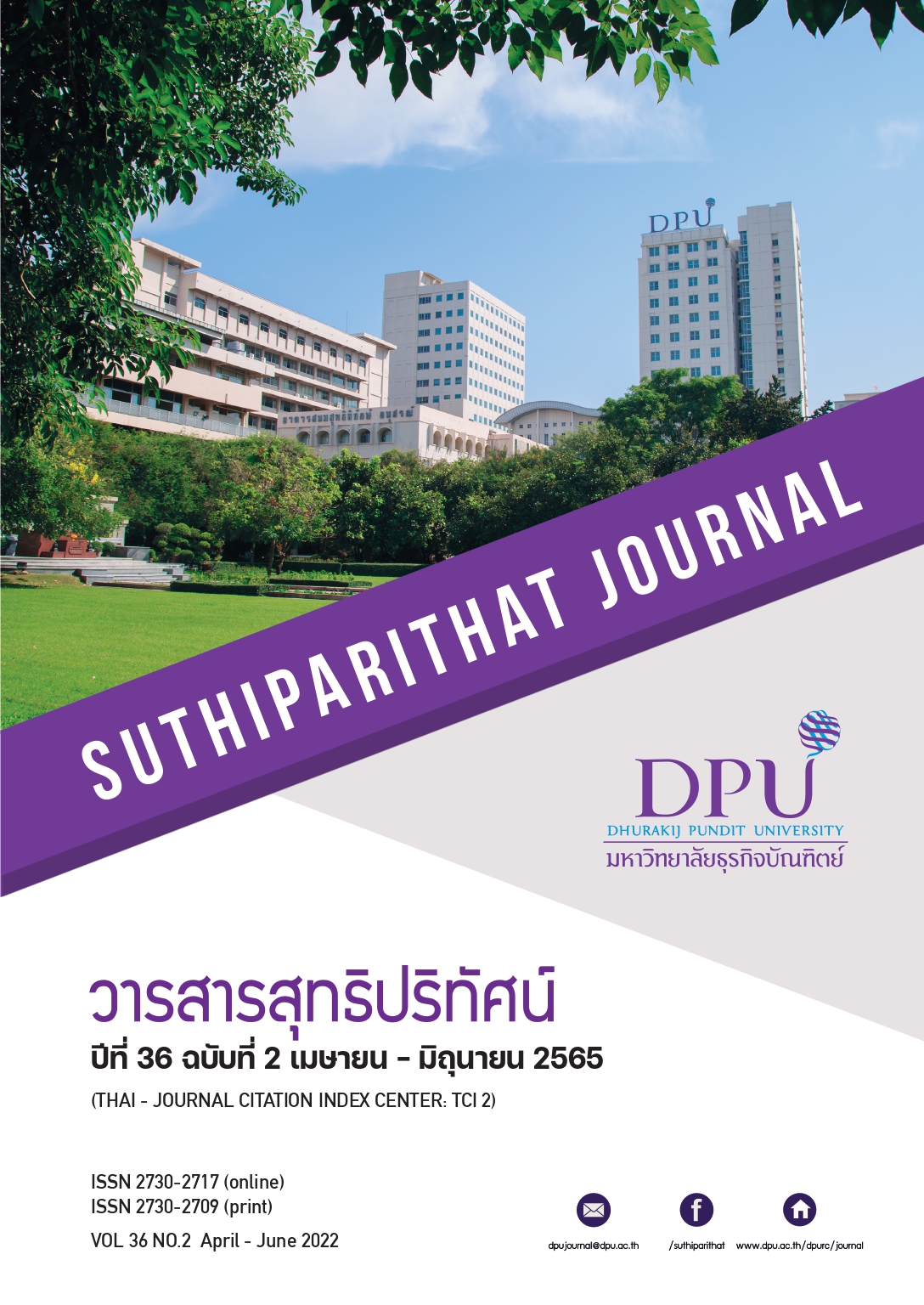การเปรียบเทียบวิธีพยากรณ์เพื่อเพิ่มความแม่นยำในการพยากรณ์ยอดขาย:กรณีศึกษาบริษัทผลิตขวดน้ำพลาสติกแห่งหนึ่งในประเทศไทย
คำสำคัญ:
การพยากรณ์ยอดขาย, Holt-Winter, การผลิตขวดน้ำพลาสติกบทคัดย่อ
การพยากรณ์ยอดขาย หรือ อุปสงค์ของลูกค้ามีความสำคัญในการวางแผนด้านต่างๆของบริษัท ไม่ว่าจะเป็นการวางแผนการผลิตและวัสดุ การวางแผนทรัพยากรมนุษย์ บริษัทหลายๆแห่งได้เล็งเห็นถึงความสำคัญของการพยากรณ์ทำให้มีความต้องการที่จะปรับปรุงความแม่นยำของการพยากรณ์ สำหรับงานวิจัยนี้มีวัตถุประสงค์เพื่อปรับปรุงวิธีการพยากรณ์ยอดขายของบริษัทผลิตขวดน้ำพลาสติกแห่งหนึ่งในประเทศไทย โดยเน้นวิธีการพยากรณ์ที่ไม่ซับซ้อนและประยุกต์ใช้ได้ง่าย โดยงานวิจัยนี้ได้แสดงวิธีการเปรียบเทียบวิธีการพยากรณ์ต่างๆเพื่อหาวิธีการพยากรณ์ที่ดีที่สุดสำหรับยอดขายขวดน้ำพลาสติกสามรุ่นที่ขายดี โดยนำข้อมูลในอดีตช่วงสิงหาคม พ.ศ. 2561 – กรกฏาคม พ.ศ. 2563 มาใช้ในการทดลอง โดยแบ่งข้อมูลออกเป็น 2 ปี ปีแรกสำหรับหาค่าน้ำหนักของวิธีการพยากรณ์ ส่วนปีที่สองใช้สำหรับทดสอบความแม่นยำของวิธีการพยากรณ์ โดยใช้ค่าเฉลี่ยของเปอร์เซ็นต์ความคลาดเคลื่อนสมบูรณ์ (Mean Absolute Percentage Error) ในการวัดความแม่นยำของวิธีพยากรณ์ ผลลัพธ์ที่ได้คือ วิธีการปรับให้เรียบแบบโฮลต์-วินเทอร์ (Holt-Winter) เป็นวิธีที่ดีที่สุดโดยมีค่า MAPE ต่ำกว่า 10% โดยต่ำสุดอยู่ที่ 4.7% และเมื่อเปรียบเทียบกับวิธีพยากรณ์ยอดขายเดิมของบริษัท วิธี Holt-Winter มีความแม่นยำมากกว่า 57% 57% และ 89% สำหรับการพยากรณ์ยอดขายทั้ง 3 รุ่น นอกจากนี้ บริษัทยังสามารถใช้แนวทางการเปรียบเทียบวิธีการพยากรณ์ในงานวิจัยนี้เพื่อหาวิธีพยากรณ์ที่ดีที่สุดสำหรับรุ่นอื่นๆต่อไป
เอกสารอ้างอิง
ดาว สงวนรังศิริกุล, หรรษา เชี่ยวอนันตวานิช, และ มณีรัตน์ แสงเกษม (2558). การศึกษาเปรียบเทียบเพื่อหาตัวแบบที่เหมาะสมสำหรับการพยากรณ์จำานวนผู้ป่วยที่เป็นโรคเฝ้าระวังทางระบาดวิทยาในกรุงเทพมหานคร. วารสารวิจัยและพัฒนา มจธ, 38(1), 35-54.
พรรณิภา คุ้มสิน, และ สมศรี บัณฑิตวิไล (2561). การเปรียบเทียบตัวแบบการพยากรณ์ยอดขายเครื่องปรับอากาศโดยวิธีปรับให้เรียบเอ็กซ์โพเนนเชียลแบบโฮลท์-วินเทอร์, วิธีบ็อกซ์-เจนกินส์ และวิธีโครงข่ายประสาทเทียม. วารสารวิทยาศาสตร์และเทคโนโลยี, 26(3), 363-376.
พิเชฐ พุ่มเกษร, อภิศักดิ์ วิทยาประภากร, และ จุฑา พิชิตลำเค็ญ (2562). การพยากรณ์ราคายางแผ่นรมควันชั้น 3 (RSS3) ด้วยตัวแบบห่วงโซ่มาร์คอฟ. วารสารวิชาการพระจอมเกล้าพระนครเหนือ, 29(1), 34-45.
ไววิทย์ พานิชอัศดร, และ มหศักดิ์ เกตุฉ่ำ (2561). การพยากรณ์ยอดขายปลีกแก๊สรถยนต์ ด้วยวิธีการวิเคราะห์อนุกรมเวลาและโครงข่ายประสาทเทียม. Journal of Information Science and Technology (JIST), 7(1), 42-49.
ศิริวรรณ สัมพันธมิตร, วรรณดา สมบูรณ์, กนกวรรณ สังสรรค์ศิริ, และ เสาวนิตย์ เลขวัต (2564). การพยากรณ์ความต้องการใช้กาวดักแมลงวัน. วารสารข่ายงานวิศวกรรมอุตสาหการไทย, 7(1), 55-67.
Brown, R. G. (1956). Exponential smoothing for predicting demand. Cambridge, Massachusetts: Arthur. D. Little.
Brown, R. G., Meyer, R. F., & D’Esopo, D. A. (1961). The fundamental theorem of exponential smoothing. Operations Research, 9(5), 673–687.
Chopra, S., & Meindl, P. (2013). Supply chain management (5th ed.). Essex, England: Pearson Education.
Holt, C. E. (1957). Forecasting seasonals and trends by exponentially weighted moving averages. (ONR Memorandum Vol 52). Pittsburgh: Carnegie Institute of Technology.
Hyndman, R. J., & Athanasopoulos, G. (2021) Forecasting: Principles and practice (3rd ed.). Melbourne, Australia: OTexts. Retrieved from https://OTexts.com/fpp3.
Jacobs, R. F., Berry, W., WhyBark, D. C., & Vollmann, T. (2011). Manufacturing planning and control systems for supply chain management (6th ed.). New York: McGraw-Hill.
Sugiarto, V. C., Sarno, R., & Sunaryono, D. (2016). Sales forecasting using holt-winters in enterprise resource planning at sales and distribution module [Paper Presentation]. In 2016 International Conference on Information & Communication Technology and Systems (ICTS) Proceedings, 8-13.
Veiga, C., Veiga, C. R. P., Catapan, A., Tortato, U., & Silva, W. (2014). Demand forecasting in food retail: A comparison between the Holt-Winters and ARIMA models. WSEAS Transactions on Business and Economics, 11, 608-614.
Winters, P. R. (1960). Forecasting sales by exponentially weighted moving averages. Management Science, 6(3), 324–342.
ดาวน์โหลด
เผยแพร่แล้ว
รูปแบบการอ้างอิง
ฉบับ
ประเภทบทความ
สัญญาอนุญาต
ลิขสิทธิ์ (c) 2022 มหาวิทยาลัยธุรกิจบัณฑิตย์

อนุญาตภายใต้เงื่อนไข Creative Commons Attribution-NonCommercial-NoDerivatives 4.0 International License.
เนื้อหาและข้อมูลในบทความที่ลงตีพิมพ์ในวารสารสุทธิปริทัศน์ ถือเป็นข้อคิดเห็นและความรับผิดชอบของผู้เขียนบทความโดยตรงซึ่งกองบรรณาธิการวารสาร ไม่จำเป็นต้องเห็นด้วย หรือร่วมรับผิดชอบใด ๆ
บทความ ข้อมูล เนื้อหา รูปภาพ ฯลฯ ที่ได้รับการตีพิมพ์ในวารสารสุทธิปริทัศน์ ถือเป็นลิขสิทธิ์ของวารสารสุทธิปริทัศน์หากบุคคลหรือหน่วยงานใดต้องการนำทั้งหมดหรือส่วนหนึ่งส่วนใดไปเผยแพร่ต่อหรือเพื่อกระทำการใด ๆ จะต้องได้รับอนุญาตเป็นลายลักษณ์อักษรจากวารสารสุทธิปริทัศน์ก่อนเท่านั้น







